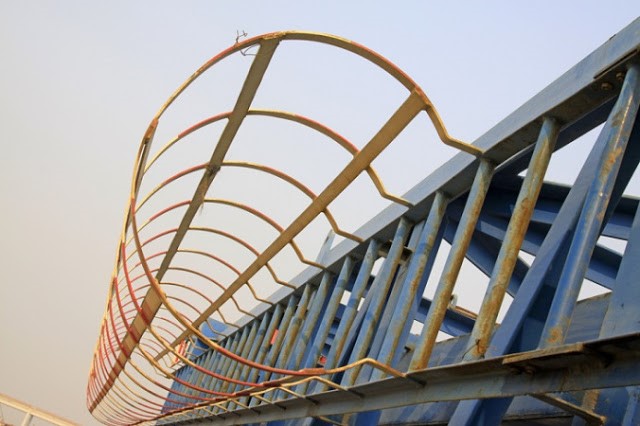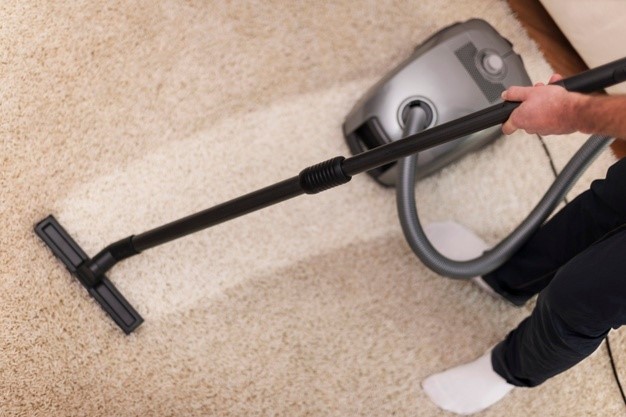Table of Contents
Most organizations are using caged ladders in plenty of industrial and commercial settings. It enables movement among mezzanines, platforms, or catwalks in buildings when installing specialized staircases is not possible. Caged Ladders are a great way to assure security and optimal functionality because they are adaptable, robust, and multifunctional.

The common uses of a caged ladder include simple access to mezzanines and roofs, high or dangerous spots such as those near high-voltage electric lines or roof edges, door/wall hatch availability, elevator pits, entrance to flooring hatches or inner roof, outdoor advertising, and sewer access.
Various Types Of Caged Ladders: Which One Is Right For You?
Before you start using caged ladders, you should be well versed with the different types of caged ladders:
- Safety Movable Caged Ladders: Such ladders are broad and have 2 or 20 steps (or more). Using caged ladders can be helpful in a variety of situations in showrooms, warehouses, stock floors, and stock rooms.
- Standard Attached Ladder: A standard ladder is employed in industrial or commercial structures to activate safety mechanisms. Accessibility to rooftops or fire escapes, for instance.
- Dock-Caged Ladders: Dock ladders are helpful in many different industries and are robust, strong, and corrosion-resistant.
- Maintenance Hole Cage-Equipped Ladder: For tall ladders, a utility hole caged built to order is indeed an excellent safety element.
- Offset Caged Staircase Ladder: Rather than having rungs, this ladder features steps.
Caged Ladders: When You Need Them And Why
Caged Ladders come in handy for various tasks, from the straightforward, like replacing a bulb, to the somewhat more difficult, like accessing a building’s rooftop for repair. But you run the risk of falling whenever you use a ladder. What if the staircase you must ascend is perched directly atop a tall office building? The climb could be challenging even if you aren’t scared of heights.
Using caged ladders can be helpful here. Basket or caged guards affixed to the buildings or the staircase contain the ladder’s mounting zone to avoid fatalities from these stationary ladders. These cages can prevent workers from tumbling backwards during a mishap by allowing them to reassert their footing or regain stability.
Why You Should Use An Aluminum Or Steel Caged Ladder
Aluminium gets you everything in terms of toughness, versatility, and durability. Using caged ladders made of aluminium has many benefits which are as highlighted below:
- Aluminium is inexpensive during its lifetime since it requires no maintenance. In addition to being less expensive than galvanized or stainless steel ladders, aluminium also requires less upkeep over tenure, saving money.
- Aluminium resists corrosion and rust. Steel ladders are either stainless steel or galvanized To reduce corrosion or rust. Moreover, Aluminum ladders cheaply and naturally resist corrosion and rust.
- Aluminium is a high-strength and Lightweight material, and steel ladders are costly to manage and carry because of their weight. Aluminium has a tremendous weight-to-strength ratio yet is lightweight, providing the ideal option for upkeep-free, durable business ladder installations.
- Aluminium is safe for the environment and is produced with recycled extrusions. Steel ladders are susceptible to rusting over time, so they ultimately need to be refurbished, which harms the environment.
- The square rungs on aluminium ladders are highly serrated for optimal safety and foot grip. Because steel ladders frequently have circular rungs and aren’t serrated, a climber will find it less secure.
- Various finishes are available on aluminium ladders. Without compromising their colour or lustre, you may repaint aluminium ladders, black anodized, bronze anodized, clear anodized, etc. Anodizing cannot be done on steel; a painting can.
- Aluminium is neither magnetic nor spark-prone. Aluminium does not ignite when hit against all other non-ferrous metals or itself, which lessens the possibility that it could catch fire. You may start using caged ladders made of aluminium in locations where magnetic gear is maintained since it is non-magnetic.
Conclusion
The tradition of using caged ladders has had been a standard tool since ages but are currently fading out. Furthermore, Research has demonstrated that cages don’t safeguard employees. Organizations should think about substituting alternate fall safety methods for caged ladders. Companies must, whenever feasible, think about substituting stairs for ladders.
Most organizations are using caged ladders in plenty of industrial and commercial settings. It enables movement among mezzanines, platforms, or catwalks in buildings when installing specialized staircases is not possible. Caged Ladders are a great way to assure security and optimal functionality because they are adaptable, robust, and multifunctional.
The common uses of a caged ladder include simple access to mezzanines and roofs, high or dangerous spots such as those near high-voltage electric lines or roof edges, door/wall hatch availability, elevator pits, entrance to flooring hatches or inner roof, outdoor advertising, and sewer access.
Various Types Of Caged Ladders: Which One Is Right For You?
Before you start using caged ladders, you should be well versed with the different types of caged ladders:
- Safety Movable Caged Ladders: Such ladders are broad and have 2 or 20 steps (or more). Using caged ladders can be helpful in a variety of situations in showrooms, warehouses, stock floors, and stock rooms.
- Standard Attached Ladder: A standard ladder is employed in industrial or commercial structures to activate safety mechanisms. Accessibility to rooftops or fire escapes, for instance.
- Dock-Caged Ladders: Dock ladders are helpful in many different industries and are robust, strong, and corrosion-resistant.
- Maintenance Hole Cage-Equipped Ladder: For tall ladders, a utility hole caged built to order is indeed an excellent safety element.
- Offset Caged Staircase Ladder: Rather than having rungs, this ladder features steps.
Caged Ladders: When You Need Them And Why
Caged Ladders come in handy for various tasks, from the straightforward, like replacing a bulb, to the somewhat more difficult, like accessing a building’s rooftop for repair. But you run the risk of falling whenever you use a ladder. What if the staircase you must ascend is perched directly atop a tall office building? The climb could be challenging even if you aren’t scared of heights.
Using caged ladders can be helpful here. Basket or caged guards affixed to the buildings or the staircase contain the ladder’s mounting zone to avoid fatalities from these stationary ladders. These cages can prevent workers from tumbling backwards during a mishap by allowing them to reassert their footing or regain stability.
Why You Should Use An Aluminum Or Steel Caged Ladder
Aluminium gets you everything in terms of toughness, versatility, and durability. Using caged ladders made of aluminium has many benefits which are as highlighted below:
- Aluminium is inexpensive during its lifetime since it requires no maintenance. In addition to being less expensive than galvanized or stainless steel ladders, aluminium also requires less upkeep over tenure, saving money.
- Aluminium resists corrosion and rust. Steel ladders are either stainless steel or galvanized To reduce corrosion or rust. Moreover, Aluminum ladders cheaply and naturally resist corrosion and rust.
- Aluminium is a high-strength and Lightweight material, and steel ladders are costly to manage and carry because of their weight. Aluminium has a tremendous weight-to-strength ratio yet is lightweight, providing the ideal option for upkeep-free, durable business ladder installations.
- Aluminium is safe for the environment and is produced with recycled extrusions. Steel ladders are susceptible to rusting over time, so they ultimately need to be refurbished, which harms the environment.
- The square rungs on aluminium ladders are highly serrated for optimal safety and foot grip. Because steel ladders frequently have circular rungs and aren’t serrated, a climber will find it less secure.
- Various finishes are available on aluminium ladders. Without compromising their colour or lustre, you may repaint aluminium ladders, black anodized, bronze anodized, clear anodized, etc. Anodizing cannot be done on steel; a painting can.
- Aluminium is neither magnetic nor spark-prone. Aluminium does not ignite when hit against all other non-ferrous metals or itself, which lessens the possibility that it could catch fire. You may start using caged ladders made of aluminium in locations where magnetic gear is maintained since it is non-magnetic.
Conclusion
The tradition of using caged ladders has had been a standard tool since ages but are currently fading out. Furthermore, Research has demonstrated that cages don’t safeguard employees. Organizations should think about substituting alternate fall safety methods for caged ladders. Companies must, whenever feasible, think about substituting stairs for ladders.



